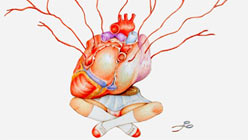Joan Didion said it so well: “We tell ourselves stories in order to live.” We take our messy lives and we insert opening scenes and arcing plots and eventual morals. We organize facts and occurrences and impressions into narratives, which we tell and retell, amend, edit, and tell again.
All of the artists included in the Hosfelt Gallery’s Vocabularies of Metaphor: More Stories tell narratives, tales both sweeping and intimate, through images. The fifteen artists in the show are predominantly female and contemporary. Henry Darger, male and deceased, is one of the few exceptions. His two panoramic drawings on display, Untitled (At Jennie Richee, Vivian Girls Carrying Guns), and Untitled (Abbieannian Flamingo Girl Scouts), serve as an aesthetic and conceptual precedent for many of the other artists’ styles and techniques.
Darger (b. 1892, d. 1973) was a reclusive janitor whose drawings of a detailed imaginary epic were discovered upon his death. His characters are based on the periodicals of his day, the simple figures of funny pages and newspaper advertisements. He multiplies the stereotypical bobbed schoolgirl to create an army he calls the Vivian Girls. Stripping them of clothes and giving them penises, Darger depicts the crowds of cherubic girls at play and also at war. Some skip and hold hands; others wear artillery belts and carry bayonets. Sagging cartoon-style palm trees and leafy elms mix in the background. It is an impossible place, yet one that is still recognizable.
Like Darger, artists Ruth Marten and Amy Cutler take familiar imagery and alter its context and meaning. Marten uses 18th and 19th-century etchings and lithographs as her starting point. She augments the dated didactic illustrations with whimsical details and colors. Jewel-colored eggs fall from a bird into a large sack in Abundance. An ornithological illustration becomes a fairy tale in Salon des Chics, as birds receive bottle cap bridal veils and bows and garlic cloves for hats. The tension comes from the relationship between the original sources’ scientific certainty and Marten’s playfulness. A lesson becomes a daydream before our eyes.
Amy Cutler creates a realm of female domesticity, one filled with printed housedresses, signature hairstyles and the dissatisfied faces of housewives. In Sugar Foot, women eat chocolate cake amidst a scene of stacked sugar sacks and a table and chairs. The grim expressions of those who sit upright tell us that the home-cooked is not always a salve for frayed nerves. The domestic can make you sick. As Darger did with schoolgirls, Cutler does with stock images of feminine domesticity, updating and individualizing the women (primarily through their clothes) to incorporate them into her own ongoing story.


